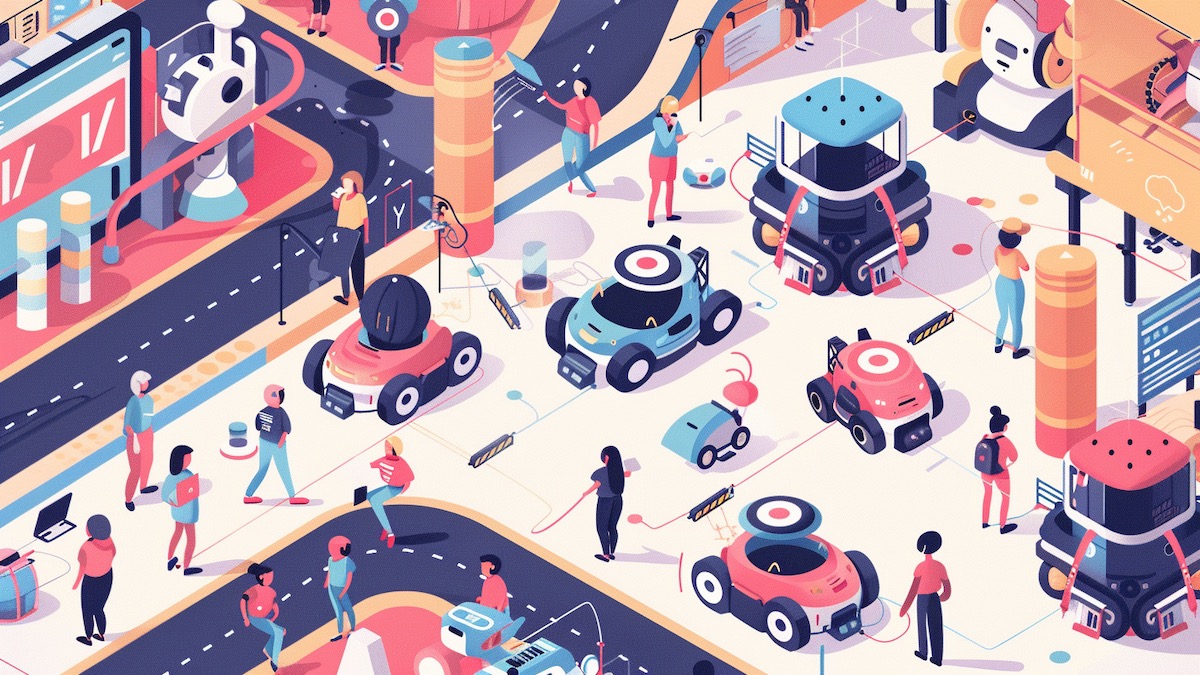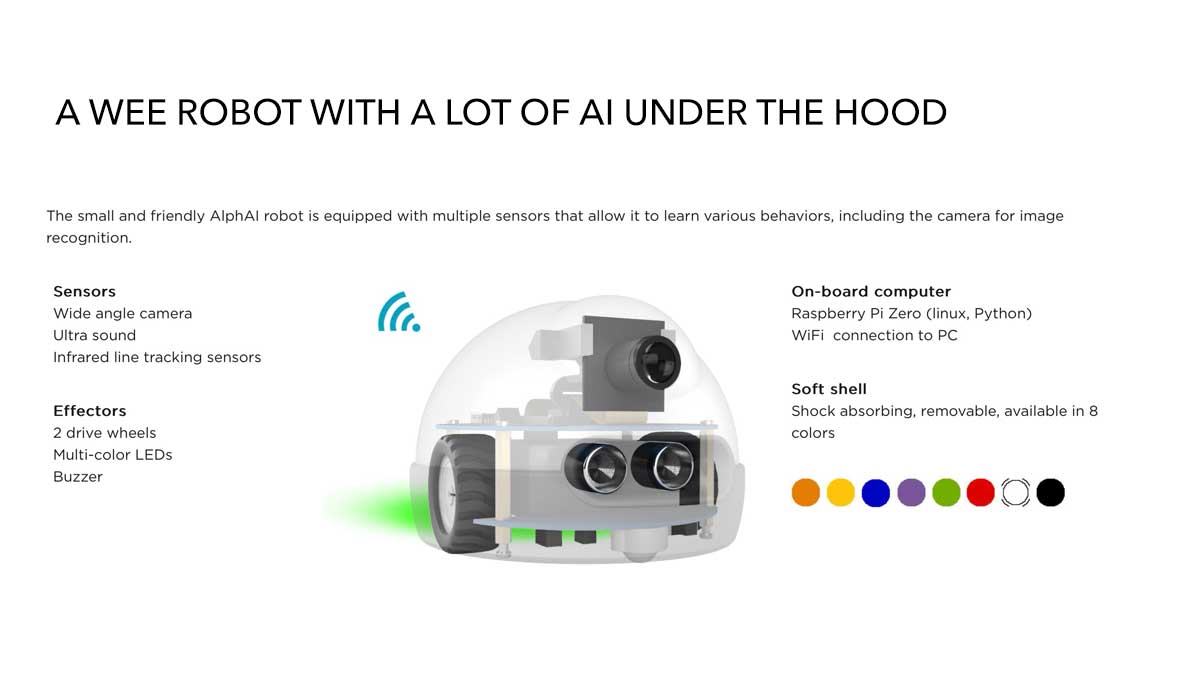Learning AI with the help of robots
Podcast (english): Play in new window | Download (10.5MB)
Subscribe: Apple Podcasts | Spotify | Android | Blubrry | Email | RSS
Thomas Deneux is the founder of Learning Robots whose aim is to help pupils, students and businesses to learn AI, with the help of home-made self-driving gizmos. These little machines on two wheels are more serious than you’d think. They are all about the teaching of advanced computing. Thomas described his philosophy to me during this interview conducted at the heart of the Neuroscience Institute of the CNRS (French National Centre for Scientific Research). In essence, a no-nonsense approach to teaching and learning AI.
When AI and robots join forces to teach artificial intelligence

Who are these friendly colourful robots?
We’re overwhelmed with social media posts and news about AI. Often, pundits will tell you that you need to know how to use ChatGPT and make prompts. That’s all very well, but we must free ourselves from the tech giants who build these models.

At Learning robots, we want to spark vocations among people who are interested in finding out how it works and want to use AI better.
What is artificial intelligence anyway? AI gave birth to these fantastic tools and programs. Yet, at the same time many people are scared. Our aim, with these user-trained robots, is to make AI accessible and friendly.
What’s behind these robots?
In our introductory activities, the user drives a robot as if it were a remote-controlled car. But behind this robot is an AI that will record all the necessary data. Next, the robot takes over from the user in autopilot mode and drives around the circuit.
Then we organise a race between the robots that have become autonomous in this way, and users may therefore observe that not all of them will perform equally well. It’s natural because performance depends on the quality of the training.
The aim is to make people understand that AI machines do not become “intelligent” out of the blue.
Behind AI, there are humans who have gathered data. And AI will only be as good as its data.

Today’s AI is still at the stage where it reproduces patterns. It’s a mere “stochastic parrot“.

In the early days of AI, there were expert systems, which worked with ever more sophisticated knowledge bases. Then we realised that rather than predicting all the potential situations, we could simply feed the AI with samples based on existing data sets and implement self-learning algorithms.
With large language models (LLMs), humongous quantities of text have become available. So much so that AI has become capable of generating text by itself. But the principle is the same: the basis is those samples provided by humans.
With AlphaAI, everything is very simple. A sensor will tell the machine what to do, for example turn left when there is light on the left. Or turn right when there is light on the right-hand side. This helps users understand the basics. After that, it’s just a matter of scaling up to more advanced AI.
What prospects can we expect from this kind of robot?
When you interact with a Large Language Model (LLM), you are essentially producing text, even though you could also generate images, music, videos, etc.
Robotics is the future of AI
But what I see emerging is that the future of AI is about robotics. The Figure start-up has just raised $675 million and has signed agreements with OpenAI, Microsoft and Nvidia to develop humanoid robots. It’s flavour of the month. Our role is not to enter this competitionMarket definition in B2B and B2C - The very notion of "market" is at the heart of any marketing approach. A market can be defined..., however.

Our vocation is educational. We want everyone to be able to get to grips with these technologies.
Our aim is to enable people to train their own AI, so that they can easily develop their own ideas, such as home automationMarketing automation in B2B enables marketing processes to be managed automatically across multiple channels. With marketing automation, companies can target their visitors with automated messages via e-mail, the web, social networks and SMS. Marketing Automation in B2B Above is a diagram explaining how the scenarios work in marketing automation, based on behavioural scoring and profiles. Messages are sent automatically, according to sets of instructions called workflows. The Limits of B2B Marketing Automation Some companies install marketing automation mechanisms while their maturity on the subject is ‘under construction’. They deploy technology for technology’s sake which leads them to use tools that projects for instance. And also make AI accessible to SMEs. Our development plans could evolve in the future to move away from teaching and training, towards a plug and play solution for introducing AI and automation into the business world.
What is your philosophy behind all this?
I’m a technophile, yet I’m not at all a techno enthusiast. I think there are some really pertinent questions being asked. And that’s why I think we need to focus on training and education.
We need to keep as many people as possible informed, to debunk all the myths about AI.
-
- On the one hand, AIs have their limits;
- Secondly, users feel immediately more comfortable with a tool after getting to grips with it.
AI can be fun
Let me tell you about an anecdote.
We work with a well-known luxury goods company in Paris, France, for whom we run autonomous robot races. Their employees train their robots for the race. The first feedback from learners on these training courses is: “I’ve realised how much AI is fun!”
It’s true that digital tools also have their downsides, such as creating addictions. But if you get to grips with them, you can achieve great results.
We need to evangelise about AI adoption, there are so many exciting potential applications for it.
I’m involved in a number of AI think tanks and I’ve realised that what the general public expects from researchers is to be told what the future will be. In fact, it’s very hard to predict the future. Innovation is about trial and error. Sometimes its adoption is faster than we think, at other times it’s not.
Always the unexpected happens.
Can we imagine a world, where chores are all carried out by machines?
I think so. We’re already seeing it in the home construction business. Tomorrow, it’s very likely that AIs will be performing a certain number of tasks. However, I hope there will still be room for humans’ creative skills.
For instance, manmade products are highly valued by consumers these days. Mass-producing widgets is easy. But creating something unique is more rewarding.
There will always be room for human creativity.
Finally, there is hope for human beings
I think so. Some people are depressed because they think they are going to be dominated by AI. But look at self-driving cars: they were supposed to be ubiquitous by 2010, and it didn’t happen.
But we shouldn’t be wearing our rose-coloured spectacles either.
Both citizens and politicians need to get to grips with the issues related to AI. As far as I am concerned, I remain optimistic about what can be achieved with these tools.
- Music and AI: Back to the Future - 07/06/2024
- Learning AI with the help of robots - 05/06/2024
- B2B vs. B2C Marketing - 13/05/2024




